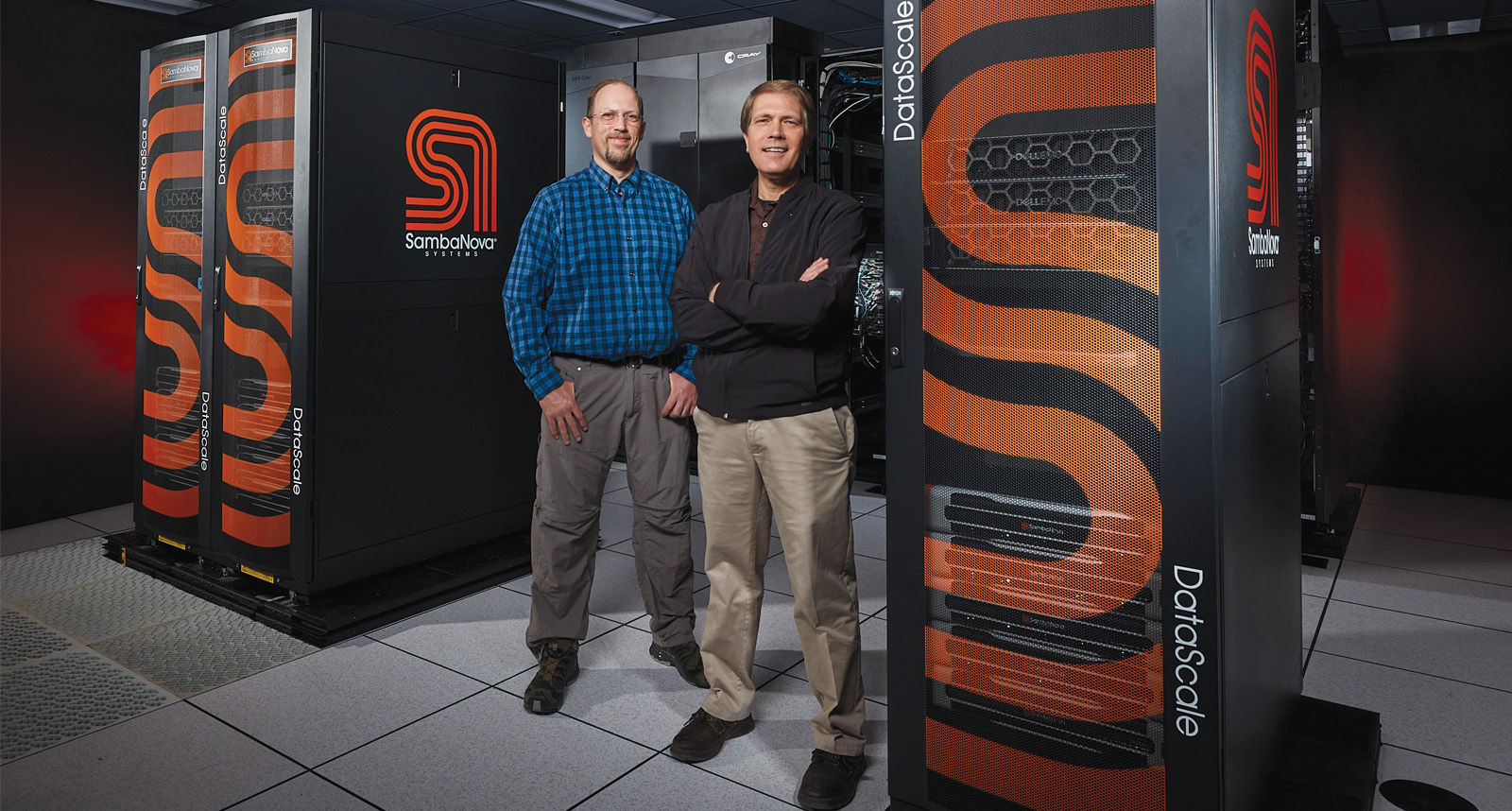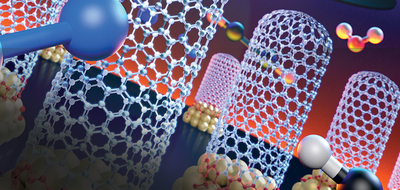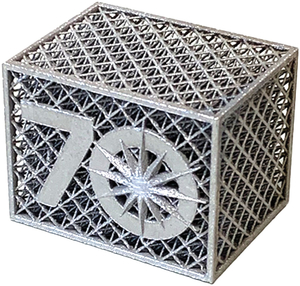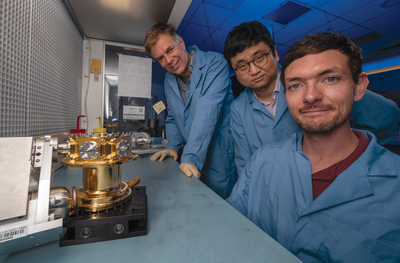Expanding the boundaries of scientific knowledge and advancing the technological state of the art to solve problems of national and global importance
Through its science and technology capabilities, the Laboratory makes fundamental discoveries about nature, develops innovative technologies that improve life and drive the economy, and carries out its mission to improve national security.
Cognitive Simulation and Machine Learning
In May 2023, LLNL and SambaNova Systems announced the addition of SambaNova’s spatial data flow accelerator to the Laboratory’s high-performance computing (HPC) systems. The new hardware is part of an effort to upgrade LLNL’s cognitive simulation program (CogSim), which combines artificial intelligence (AI) with HPC. Deep neural network hardware architectures are used to accelerate traditional physics-based simulations. Connecting the underlying physics to experimental data is an extremely difficult scientific challenge. CogSim AI techniques hold the key to teaching existing simulation models to better mirror experiments and improve the feedback loop between experiments and models.
AI and machine learning (ML) are widely used throughout the Laboratory to accelerate scientific discovery. For example, LLNL materials and computer scientists have developed a novel ML model that can predict 10 distinct polymer properties from known data sets more accurately than ever before. Discovering suitable polymer materials for use in applications ranging from packaging to solar cells depends on accurately predicting the properties of candidate materials. The model’s success lies in a new polymer representation that compactly captures the polymer’s structure combined with powerful graph-based ML techniques that autonomously learn how to best describe that structure. Previous ML approaches to predicting polymer properties could not capture the polymer’s periodicity, leading to inaccurate predictions. The new ML model will enable new concepts in polymer chemistry to be rapidly tested and iterated upon for a large application space.
Nano Forests, Big Possibilities
Carbon nanotubes (CNTs)—hollow graphite cylinders measuring up to 5 nanometers in diameter and tens of micrometers long—are the focus of several Livermore research efforts. CNTs have unusual strength, stiffness, and thermal and electrical conductivity. They enable faster proton transport than that in biological channels. LLNL scientists have keen interest in scaling up the production of packed arrays of vertically aligned single-walled CNTs, often called forests. Order and alignment of CNTs strongly influence the material’s macroscale performance. Use of forests rather than unorganized CNT structures could revolutionize a host of commercial applications, such as energy storage and water purification. The LLNL research team demonstrated growth of vertically aligned single-walled CNTs at wafer scale under a variety of synthesis conditions and derived a kinetics model to interpret the observed growth trends. The model indicates that appropriate choice of the growth recipe and fluid dynamic conditions can significantly increase the production throughput of CNT forests.
Other LLNL scientists have applied a neural network interatomic potential within advanced computational models to understand the hydrogen bonding of water confined in single-walled CNTs. This potential allowed an efficient, computationally accurate examination of confined water for a wide range of CNT diameters at time and length scales beyond the reach of conventional first-principles approaches. An improved understanding of hydrogen bonding in nanopores bridges knowledge gaps in the structure and dynamics of confined water and promises to advance various applications, including ion-selective membranes for water desalination.
Advancing Component Design and Manufacturing
Over the last decade, Laboratory breakthroughs in additive manufacturing—often called 3D printing—have enabled production of nanoscale precision components with previously unobtainable properties made from an ever-expanding variety of materials. An invention this year was a 3D-printed material capable of replicating characteristics of biological tissue. Engineers and chemists at LLNL and Meta produced a material that is stretchable to around 200 times its original properties, and as its gradient transitions from soft to stiffer material, its toughness increases by 10 times. It can be tailored for energy-absorbing materials, soft robotics, and wearable electronic devices, including those for enhancing human performance. Other researchers at the Laboratory developed a method for detecting and predicting strut defects in 3D-printed metal lattice structures during a print using a combination of monitoring, imaging techniques and multiphysics simulations. The ability to monitor build quality in situ to decide, on the fly, if the part will satisfy quality requirements is important for manufacturing high-strength, low-density metallic lattices.
Laboratory engineers are also making major strides toward closing the gap between design and manufacturing. This year, they adapted the Livermore Design Optimization (LiDO) code to accelerate the development cycle for new parts. LiDO works in tandem with Serac—a high-order nonlinear thermomechanical simulation code—to automatically generate optimal designs based on performance metrics. Previously, designers had to write unique code to integrate Serac simulations into the LiDO framework, requiring every solver to use a separate subroutine or wrapper function. Now, designers can use a single wrapper for all Serac solvers, reducing the time, energy, and maintenance burden to facilitate changing design needs. LiDO is integral to a DOE HPC initiative that aims to create “digital twins” for expediting design and production of aerospace components.
Focusing on Asteroids
Scientists in LLNL’s Planetary Defense Program and external collaborators published the first peer-reviewed scientific results from NASA’s successful Double Asteroid Redirection Test (DART), which took place on September 26, 2022. Since the DART spacecraft effectively deflected the 150-meter Dimorphos moonlet and changed its orbit around the larger Dimorphos asteroid, Laboratory researchers have been applying machine learning and multiphysics simulations, such as Monte Carlo approaches, to evaluate the data. The study provides a first look at the effects of kinetic impact on the orbital velocity of Dimorphos and identifies that substantially more momentum was transferred to the asteroid from the escaping impact ejecta than from the impact of the spacecraft itself.
This year, LLNL also saw its fourth-generation high-purity germanium gamma-ray sensor begin its 2 billion-mile journey to make the first-ever visit to Psyche, the largest metal asteroid in the solar system. Thought to be the remnant of a planetary core, Psyche offers a rare opportunity for researchers to study and better understand planet formation and the hidden cores of Earth, Mars, Mercury, and Venus. The sensor is an essential part of a gamma-ray spectrometer built in collaboration with researchers from Johns Hopkins Applied Physics Laboratory.
Materials Science Mysteries Revealed
Through the combined power of simulation and experiments, Laboratory scientists and collaborators have provided answers to longstanding mysteries in materials science. One team developed a scaling law for analyzing kinetics related to high-pressure, rapid solidification of metastable liquids observed in experiments over the past few decades. The researchers used a dynamic-compression platform to rapidly compress liquids in just tens to thousands of nanoseconds, allowing them to explore exotic liquid states that solidify at pressures far beyond what phase diagrams predict for equilibrium conditions. The new scaling law explains and quantifies a surprising compression-rate dependence across different experimental platforms and could accelerate capabilities for engineering and synthesizing novel materials via high-pressure techniques. LLNL scientists have also identified a previously unknown ejecta production mechanism called shallow bubble collapse (SBC). It is not based on Richtmyer–Meshkov instabilities (RMI), a heavily researched process that was believed to be the main source of shock-driven ejecta production in metal surfaces. The team used high-resolution modeling of various shock conditions to identify regimes that behaved computationally different than RMI theory and then designed and fielded experiments to evaluate those conditions. The researchers found SBC can produce ten times more ejecta with two times higher temperature than RMI under similar shock strengths, presenting a new phenomenology of multishock ejecta production.
Aboard the International Space Station
The LLNL-developed Stellar Occultation Hypertemporal Imaging Payload (SOHIP) prototype telescope is fully operational on board the International Space Station (ISS). The telescope met rigorous NASA safety requirements for inclusion on the ISS—a Laboratory first—and is already measuring atmospheric properties with high resolution at unprecedented altitudes. SOHIP uses LLNL-patented monolithic optics technology on a gimbal to detect and characterize gravity waves (oscillations of air that transport energy and momentum from the lower to the upper atmosphere as they propagate vertically and horizontally) and high-altitude atmospheric properties such as temperature, pressure, and air density profiles at altitudes up to 50 kilometers. In addition, a five-year study led by Livermore and NASA researchers of the ISS and its astronauts concluded that the habitat is safe for its residents. The ISS is one of the most uniquely sealed environments in existence, with only the arrival of new astronauts and supplies introducing new microbes. The microbiome of space station surfaces resembled that of the crew member’s skin. The samples were processed using the Livermore Metagenomics Analysis Toolkit, a bioinformatics software that rapidly identifies microbes—including bacteria, viruses, or fungi—from vast DNA sequence data.
Tackling Cancer on Multiple Fronts
LLNL scientists are pursuing wide-ranging efforts to combat cancer. As part of DOE’s Exascale Computing Project, Livermore computational scientists helped develop the CANDLE (Cancer Distributed Learning Environment) software suite, which brings together machine learning, deep learning, and research data to accelerate discovery of new therapeutics and treatment options. The team developed a theoretical model, based on Dynamic Density Functional Theory, to enable more efficient molecular-level simulations of cell membranes and their lipid–protein interactions. The new model simulates molecular interactions at greatly improved length (micrometer) and time (seconds) scales, providing cancer researchers with key capabilities to investigate the behavior of cancer-causing proteins. The CANDLE project garnered a 2023 R&D 100 Award from R&D World Magazine.
Research teams are also developing novel platforms for studying the pathogenesis of cancer types that are extremely difficult to treat. A Livermore–University of California at Davis collaboration has created a 3D platform using engineered bone marrow to study how microenvironmental and immune factors affect tumor progression for patients with osteosarcoma—the most common primary malignant bone cancer in children and adolescents. A separate LLNL team has devised a bioreactor platform to study tumor organoids from patients with colorectal cancer and subsequent stage IV liver metastasis. This in vitro platform can help researchers better understand tumor progression and treatment resistance. Such tools have potential to accelerate drug screening and discovery and improve patient outcomes.
Jupiter Laser Facility Experiments
In FY 2023, the DOE Office of Science announced provision of $28.5 million in funding for LaserNetUS. The network of facilities operating high-intensity, ultrafast lasers provides open and free access to researchers and enables students to conduct work for their dissertations. LLNL’s Jupiter Laser Facility (JLF) has been part of LaserNetUS since its inception in 2018. Experiments at JLF, conducted by Laboratory researchers and external users, are capitalizing on upgrades made during a four-year project to refurbish the facility. With its unique capabilities to perform hands-on high-energy-density science experiments, JLF can play an important role in advancing inertial fusion energy in addition to discovery plasma science. For example, a postdoctoral fellow at LLNL’s High Energy Density Science Center is conducting innovative plasma physics experiments at JLF that “twist” laser light and create some of the strongest magnetic fields ever generated by a laser.
Dense Plasma Focus Radiography
The LLNL Megajoule Neutron Imaging Radiography Experiment (MJOLNIR) achieved greater than 1012 neutrons in a single deuterium gas shot in 2023. The result is a major step toward their goal of 1013 neutrons and tighter spot size, which would allow for taking still-frame pictures of light elements undergoing highly dynamic processes, for example, during subcritical experiments at the Nevada National Security Site. The MJOLNIR dense plasma focus (DPF) neutron source runs powerful electrical currents through a gas, which causes it to ionize into a plasma before generating an intense magnetic field that compresses the plasma. This pinching creates a bright but brief (100 nanosecond) flash of neutrons for rapid-fire photography. High-performance computing simulations complement the experimental activities, assisting in their design and in developing an improved understanding of DPF neutron pulse creation.










